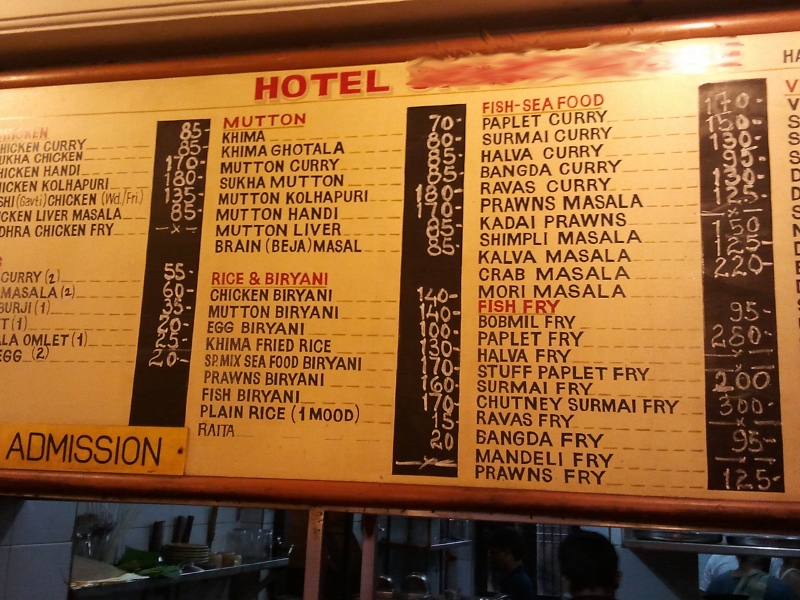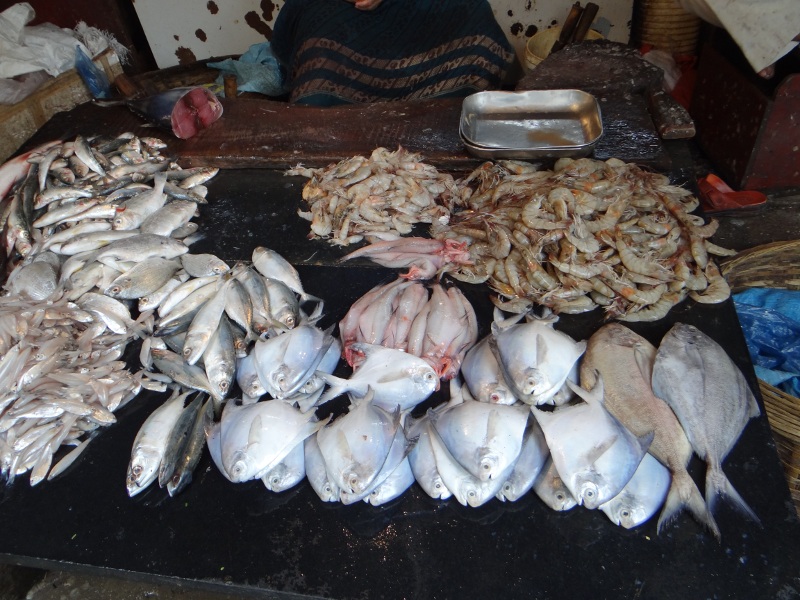Bombil Fry
Bombil Fry
"We are famous for our live crab", the restaurant manager proclaimed with a smile. "We show the crab to the client, before cooking it to perfection, however they wish", he added. I was at an Oriental speciality restaurant in posh south Bombay, for a survey I was conducting as part of a class project. Each of my classmates went to different regions of coastal India in an attempt to understand the current trends in seafood consumption in south India. We were trying to answer questions like: which are the seafood hotspots in the country, where is the seafood coming from, is there a broad pattern of customer preference for each region, how much of a 'locavore' is the average (sea)foodie, and what is on a typical menu at a restaurant serving seafood. And this was the third time I was encountering "live crab" in two days, incidentally at a restaurant serving south Asian cuisine. Was this a coincidence?

At a popular seafood restaurant in Mumbai
"Beware the basa", my marine ecologist colleagues warn me. A whole host of fishes whose identities are, well, fishy (pun unintended) end up on a fancy plate masquerading as basa. Truth be told, the word 'basa' was not mentioned in either of the fish markets I visited, but many restaurants seemed to be offering sea bass. Curiouser and curiouser. I eavesdrop on some conversations and an interesting tidbit is thrown from the other end of the classroom - did you know that a lot of basa is imported, usually from Vietnam? Hmmm. That is a big help. This import explains the incongruous "Chilean", "Andean", and "Norwegian" sea bass in otherwise Asian-themed restaurants.
The import of seafood in India is quite surprising for a number of reasons. Firstly, most restaurants seemed to serve fresh fish with pride and importing seafood typically implies frozen or canned food. The restaurants also seemed to be aware of how much seafood was needed on a daily basis. The smaller joints in fact had their owners juggling a lot of responsibilities - one would find them at the cash counter and many would boast of visiting the markets or docks of Mumbai to get fresh catch everyday. These were the places that wore their 'Malvani' delicacies on their sleeves and had no reason to import seafood. Most places had some cold storage or deep freezer, with food stalls having at least refrigerators. The larger establishments, especially the seafood speciality ones, had no issues with seafood availability, since the middlemen they depended on guaranteed supply all year long. Even these rarely stored more than ten kilograms at a time and this was for a couple of days at the most. Where encountered, crab was either the 'live crab' variety or frozen crabmeat, especially in the oriental joints that are new to the restaurant scene. Some of the fish that was imported from abroad still had me stumped - why would a Chinese restaurant be serving Chilean sea-bass? On the other hand, there seemed to be significant demand for some fish from West Bengal such as the trademark hilsa, which were surprisingly popular in Indo-Chinese restaurants. Imported seafood seemed rather unpopular in most places, albeit present in south Asian-themed restaurants. In all likelihood, the import of seafood from other other states as well countries is a cosmopolitan concept - a reasonable assumption to make since villages and towns would neither want nor afford this.
If Mumbai is, debatably, the party capital of the country, and prawns are the undisputed royalty of party food, then how much of it is consumed, on average, in bollywood boulevards? I don't have an actual answer to that, so we can make that a rhetorical question and leave it there for now. Apparently, any cocktail party in town that does not involve a prawn hors d'oeuvres, cannot claim to be a party. While the veracity of that needs to be tested, a majority of restaurants claimed prawn to be their no. 1 seller in terms of popularity and many considered it the most profitable seafood on their menu. It was also rather popular in places serving alcohol. The all-time favorite fish (which ranked higher than prawns) were surmai and pomfret, and almost every restaurant serving seafood had one or both. They seemed ubiquitous across restaurant categories and cuisines, probably due to their easy availability as well as the versatility with which they melded into a variety of preparations. These three were popular in all the south Indian states that were surveyed for the study.

At a fish market
Bombay duck (bombil in Marathi) is an iconic fish - anything with such charmingly unresolved etymology and cultural affinities to a region, usually is special. It also happens to be a fairly large fish that is fast disappearing from these waters. If one associated the sobriquet of "Auld Reekie" with the city of Edinburgh in Scotland, closer home apparently the unique smells of the Bombay Mail transporting this local delicacy to the fish-adoring west-coast during the British Raj, ensured that people always associated the odour to the Bombay Daak (or Mail). One story goes that the characteristic smell of the fish arriving by the Bombay Daak became synonymous with the train but somehow got perverted to Bombay Duck and the name stuck. The confusing name notwithstanding, it seems as popular as ever in Mumbai. However, colleagues from other parts of the Konkan region reported that they hardly found bombil on any of their surveys. In the Malvan region of Maharashtra, there were apparently no restaurants serving this, while colleagues in Goa found one fish market where it was available. This is good news at some level - at least it is no longer exported in significant numbers to other parts of the country. A local delicacy that only tourists try when in Mumbai is a much nicer prospect if you are a sea critter, I suppose. However, this did not seem to be the scenario. It appears, from conversations during the survey, that it is most popular with locals followed by Indian tourists, for most part. This implies a high demand throughout the year which can be more detrimental than in the case of seasonal visitors. Bombil was rarely served in the high-end restaurants, making the occasional foray (if at all) during themed parties and food festivals. A web search tells me that the export of bombil outside India might be a different tale with twists aplenty, and although interesting will be ignored here to focus on other fish tales from Mumbai.
While research indicates an actual drop in the abundance of most large fish, apparently thanks to overfishing and global change, a vast majority of restaurateurs, spanning the gradient between tiny food stalls to five star hotels, are blissfully unaware of the churning of the ocean. To them, seemingly, customer is still king. They may hike the price if something is hard to procure, they may look to other markets and sources of procurement, but rarely would they not serve something that is popular among their seafood enthusiasts. Most restaurant and food-stall owners I interacted with were of the opinion that seafood is almost never profitable - they claim that margins are very low if at all, and many even said they offer seafood even though it is at a loss and they try to make it up with other means or by compromising on quantity. This polarised the seafood restaurants - half of them were perfectly comfortable with saying a particular item was not unavailable while others tried their best to avoid being put in such a situation.
The bottomline is: consumers drive this industry. With this, the onus has been dumped squarely on the customers - to try and find where their food is coming from, to be more aware that how and what you eat is related to environmental and conservation issues that ought not be ignored, and to know the benefits of eating responsibly. This is less of an issue in the small fishing villages that abound coastal India where the route to the plate is fairly clear. The convoluted mazes with innumerable middlemen in cosmopolitan coastal cities are different and after a point no one cares where the shrimp you are eating is coming from. However, the customer (seafoodie?) is just one of the consumers of the fisheries industry. There are other, not-so-obvious consumers that have been spawned off by indisciminate fishing and use of bycatch. As some studies have shown, bycatch and anything caught in the net that is not suitable for human consumption have huge markets in the chicken feed and pet food industries. A classic chicken-and-egg situation between supply and demand. Where target fishing used to be big problem, now indiscriminate fishing seems to be an even bigger problem, but that is different story.
Many of the larger establishments had managers with whom one ended up interacting, while the smaller ones typically had their owners usually hanging around doing one odd job or the other. And, one always looked forward to interacting with the owners. A rule of thumb that I came up with was that smaller the establishment, more the awareness about all things fishy thereby making coversations very interesting - one never knew what little tidbit could be picked up. While everyone was polite in general and I always had a glass of water offered graciously irrespective of the place, the proprietors were generally very happy to talk shop and more hospitable than managers. Moreover, complimentary solkadi and chaas (spicy buttermilk) after walking from one place to the next always implied an interesting interaction was on the cards. Many of the larger establishments seemingly suffered from a disconnect between their kitchens and service, and more so in the case of restaurant chains. This meant that managers would say that only the head office knew the whole story and they rarely got to deal with even the middlemen. On the other hand, the small scale proprietors were aware of issues ranging from trawling and overfishing to even climate change and indiscriminate fishing.

Fishermen at work near Marine Drive
At the end of my last day of surveying, I stood at Marine Drive, drifting into a reverie about the various encounters, watching a couple of tiny fishing boats at sundown. Each had two men, very obviously fishing, not very far from the promenade and parallel to it. It had been cloudy all day and monsoon had definitely begun in Mumbai. It started to drizzle and in typical bombaiyya fashion, the evening filled out with joggers doing their thing, couples enjoying the sunset, friends talking about the mundane, part-time philosophers discussing world problems, hawkers selling food and various forms of plastic, employees weaving their way back home, and dogs being walked, leashes straining as a friend or foe is subjected to a volley of appropriate barks. The usual cliches against a picture postcard Bombay day. I had my back to all of this, facing the fishermen and the sea. Out of place, a lone crab clambered over those mysterious Giant's Causeway-esque slabs, as though fighting against the cliches. And the fishermen. Was this a coincidence?
A version of this appeared in Conservation India in 2014 : Something Fishy - Emptying India's Seas